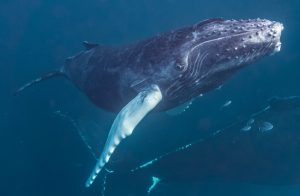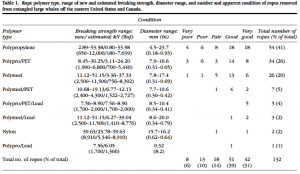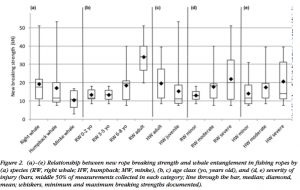Effects of fishing rope strength on the severity of large whale entanglements
By Leila AtallahBenson, SRC Intern

Figure 1. A free swimming humpback whale, that managed to avoid fishing gear entanglements.
On top of whales being majestic giants that are exciting to watch, they are also an important animal for marine ecosystems. They enhance primary productivity in nutrient lacking areas and ocean surfaces, and their carcasses provide habitat and energy sources for deep-sea species1. In both these instances, whales fix carbon, turning inorganic carbon to organic compounds. This not only makes more room for carbon to be absorbed, helping with global warming, but contributes to the available amount of organic matter that marine organisms utilize. Whales are also important to the economy, drawing in around $2 billion per year through whale-watching businesses2.
Unfortunately, these species are prone to human fishing gear entanglements, since they are so large and often spend time in prime fishing areas. Once a whale is entangled the individual can drown quickly, or may be able to breath but later dies from starvation, injuries endured by the fishing gear, increased energetic demands, or stress3. These entanglements often come from pot/trap and gillnet fisheries4. Protecting these species not only helps whales, but helps protect our oceans and economy.
Between 1994 and 2010, Knowlton et al. explored the breaking strength of 132 fishing ropes that were found on 70 whales. This included 30 right, 30 humpback, 2 fin, and 8 minke whales, all along the east coast of the United States. In the U.S., fin and humpback whales are protected, and both in the US and Canada, right whales are protected by law. All of the whales that rope was collected from were categorized by species. Right and humpback whales were also separated by age group. The severity, configuration, and any injuries of the entanglement were recorded with pictures.
Most of the gear sampled was retrieved by the Atlantic Large Whale Disentanglement Network. The entangled rope strength was determined. The majority of entangled rope was found to be in good or very good condition. The rope material, its diameter, breaking strength, condition, and how many of that rope found were considered (table 1).

The authors asked a few questions from this information. One question was if injury severity is related to rope strength? For right whales this proved to be true. With increased rope strength, right whales had more severe injuries. However, this was not true for humpback whales, whose injuries did not get worse with rope strength, but their injuries seemed to be more randomized.
Another important question asked was if rope strength correlated with whale species or age (see figure 2)? Some of these correlations were clear to see in the evidence. Both right and humpback whales were found with ropes of higher breaking strength than minke whales. Adult right whales were found in significantly stronger rope than juvenile right whales, and both adult and juvenile humpback whales. The average breaking strength was 19.30 kilonewton (nK) for right whales, 17.13 kN for humpback whales, and 10.47 kN for minke whales. The 2 fin whale ropes were 11.12 and 31.14 kN.

This information helps us take a better look at the fishing gear we use now, and allows us to make changes to better protect these magnificent creatures. There were only limited numbers of whales that were entangled in rope strengths below 7.65 kN. The use of special ropes, called reduced breaking strength (RBS) ropes, of 7.65 kN or less could reduce whale entanglements at least by 72%. Fisherman in the study area haul about 2.24-3.11 kN for lobster, 2.45-3.11 for stationary gillnets, and at most 6.38 nK for dragging gillnets. These RBS ropes of 7.65 would work for these normal fishing endeavors, and save the whales at the same time. So the next time you’re going out fishing, be sure to grab some RBS rope and help save the whales!
References
Knowlton AR, Robbins J, Landry S, McKenna HA, Kraus SD, Werner TB. 2015. Effects of fishing rope strength on the severity of large whale entanglements. Conservation Biology: 1-11.
1 Roman J, Estes JA, Morissette L, Smith C, Costa D, McCarthy J, Nation JB, Nicol S, Pershing A, Smetacek V. 2014. Whales as marine ecosys- tem engineers. Frontiers in Ecology and the Environment 12:377– 385.
2 O’Connor S, Campbell R, Cortez H, Knowles T. 2009. Whale Watching Worldwide: tourism numbers, expenditures and expanding economic benefits, a special report from the International Fund for Animal Welfare, Yarmouth MA, USA.
3 Moore MJ, van der Hoop J, Barco SG, Costidis AM, Gulland FM, Jepson PD, Moore KT, Raverty S, McLellan WA, editors. 2013. Cri- teria and case definitions for serious injury and death of pinnipeds and cetaceans caused by anthropogenic trauma. Diseases of Aquatic Organisms 103:229–264.
3 Cassoff RM, Moore KM, McLellan WA, Barco SG, Rotstein DS, Moore MJ. 2011. Lethal entanglement in baleen whales. Diseases of Aquatic Organisms 96:175–185.
3 Pettis HM, Rolland RM, Hamilton PK, Knowlton AR, Kraus SD. 2004. Visual health assessment of North Atlantic right whales Eubal- aena glacialis using photographs. Canadian Journal of Zoology 82: 8–19.
4 Johnson A, Salvador G, Kenney J, Robbins J, Kraus S, Landry S, Clapham P. 2005. Fishing gear involved in entanglements of right and hump- back whales. Marine Mammal Science 21:635–645.
